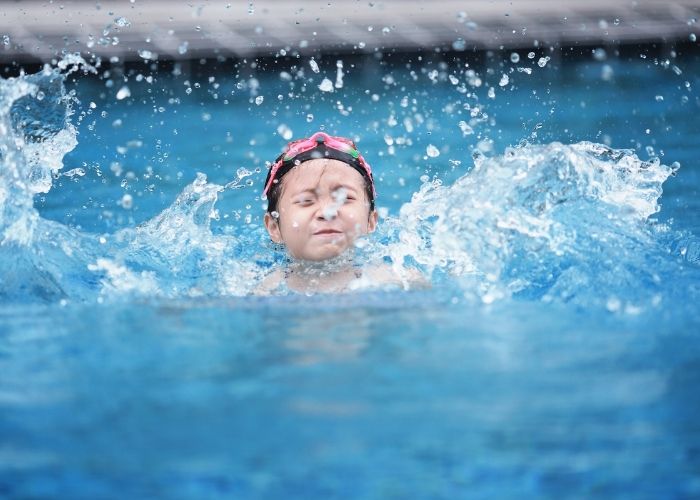MADRID – What could be better than having a swimming pool at your house in Spain? Whether that is a communal pool or a private pool in your own garden, you can enjoy yourself in the country where the mercury reaches great heights in summer.
Spain has a long summer, which attracts millions of tourists. Most of these millions of tourists spend their time on or near the very long coastline. They often stay in houses or apartment complexes with swimming pools. So that’s a lot areas with water where accidents can also happen. Every year, information campaigns are launched by various authorities to prevent these accidents as much as possible. Here are some helpful tips.
Fence and lifeguard
Rules apply to swimming pools for communal use that guarantee the safety of local residents. For example, there must be a fence of at least 1.22 metres high with a gate that closes automatically and can only be opened by authorised persons. Some regions, including Madrid, require a “vigilante” or “socorrista” (lifeguard) at every community pool. Valencia or Catalonia and some other regions, only do this when a pool is larger than 200 square metres. Whereas some different regions look at the number of homes associated with an urbanisation to determine whether a lifeguard is required.
Private swimming pool
The foregoing is of course different in your own garden. You have to take precautions there yourself. Swimming pools are very attractive to young children, even when it is not time to swim. The clear blue water can look very appealing to active toddlers or confident preschoolers. The danger is that children can disappear under the water before the watchful eyes of adults within minutes. It happens almost on a daily basis. Drowning is the second leading cause of death for children aged 1 to 4.
Most of these horrific accidents take place in home swimming pools. And there countless numbers of these in Spain and in all shapes and sizes. Fortunately, such a disaster can be averted if you take a series of measures. There are several ways to keep children safe all year round near swimming pools, hot tubs, Jacuzzi’s in your own garden, at the neighbours or during a holiday.
Between 2013 and 2015, 58% of reported drownings of children under 4 in Spain took place in a swimming pool or spa in their home. Most of the children drowned when they wandered (away) from their homes and fell into a pool where no fence or cover was installed. They went out the door or climbed through a window to get to the pool. In drownings of small children, it was found that nearly 70% of children were not expected to be in or around the pool. Yet they were found in the water.
Security gates
Swimming pool safety fences have been shown to be the most effective way to prevent young children from drowning. Keep in mind the fence is not for little feet to climb and that there are no objects nearby, such as patio furniture or play equipment that your child can use to clamber over the fence. If it is a fence with vertical bars, make sure that the distance between them is no more than 10 centimetres. This also keeps small pets safe. The gate must also have an automatic locking system and a gate that only opens outwards from the area where the pool is located. The release must be at least 1.37 metres above the ground.
Alarm
In addition to the safety fence, alarms can provide additional security around the pool. Make sure they work and have new batteries. Pool alarms can detect ripples on the water’s surface and sound to warn that someone has fallen into the pool. Such an immediate warning is urgently needed because children can drown within seconds with just one splash. However, an alarm should never be a substitute for a properly installed pool safety fence and other precautions.
Pool covers
Finally, pool covers that cover the entire pool so that a child cannot slip under are also a good security alternative. Make sure there is no standing water on the deck. Children can drown in less than 5.08 cm of water. Automatic swimming pool covers are often the safest and easiest to use.
Remember: Solar floats (for pool heating) and winter covers are not safe covers and can actually increase the risk of drowning. Floating covers inappropriately give the pool surface a solid appearance, so that a young child can reach for, say, a ball that has fallen on it and then slide into the water.
What else can parents do?
Even when safety precautions are taken, parents should be prepared in case children can reach the pool undetected. It is important that older children who can swim always warn you before swimming and that they always check the depth of the water before diving in. Small children who play in the water or near the water should wear a life jacket instead of swimming armbands. Tell them not to run around the edge of the pool. Always have a float or other object that can be used for a rescue. Always keep an eye on children. Designate one person as the ‘babysitter’ with the task of keeping an eye on all children and teenagers who are swimming or playing near the pool, even if they can swim.
Swimming pool covers from Dekobo
Would you like to know more about safe swimming pool covers? Then take a look at the website of Dekobo, manufacturer of automatic swimming pool covers, custom made if necessary. Dekobo is located in Pedreguer (Alicante) and delivers throughout Spain.


